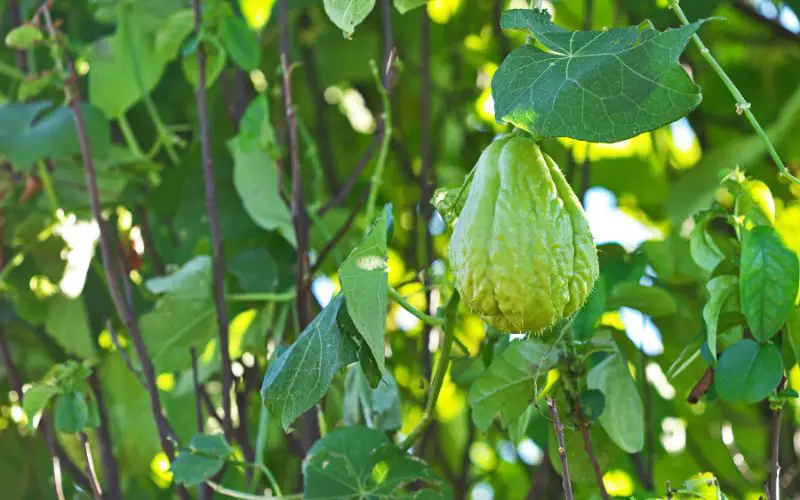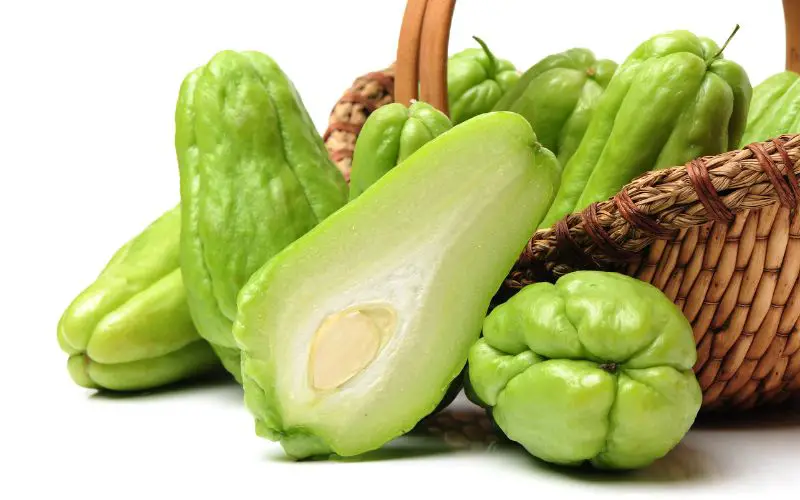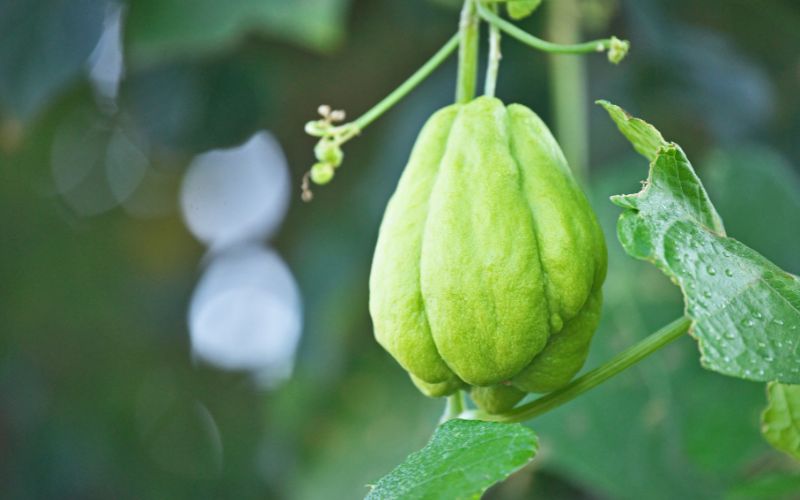Chayote, also known as mirliton, is a perennial vine native to Mexico and Central America.
The fruit of the chayote plant is eaten as a vegetable, and it is also used in salads, stews, and soups.
Chayote can be grown in pots or in the ground, and it is relatively easy to care for.
Chayote needs warm conditions and should be planted outdoors when frosts have ended. It will need a warm summer to thrive with average temperatures of over 30 degrees centigrade. Your Chayote plant will need at least 3 to 5 months of warm, frost free weather to develop fruit which can be harvested.

How to grow Chayote
Chayote can be grown in pots or in the ground, and it is relatively easy to care for.
If you are growing chayote in a pot, choose a pot that is at least 18 inches wide and has drainage holes.
Fill the pot with a well-draining potting mix and plant the chayote seedling about an inch deep. Water the seedling deeply and keep the soil moist.
Place the pot in a warm, sunny location.
If you are planting chayote in the ground, dig a hole that is twice as wide as the root ball and just as deep.
Amend the soil with organic matter such as compost or manure. Plant the chayote seedling at the same depth it was growing in the pot.
Water deeply and keep the soil moist.
Place a trellis or other support near the plant so that it can climb.
Water your chayote plant regularly, giving it about an inch of water per week.
The soil should be kept moist but not soggy. Fertilize your chayote plant every two weeks with a balanced fertilizer such as 10-10-10.
Chayote fruits will mature in three to five months.
They can be harvested when they are about 6 to 8 inches long and have a pear-like shape.
To harvest, cut the fruit from the vine with a sharp knife. Chayote can be eaten raw or cooked, and it can be stored in the refrigerator for up to two weeks.
What varieties of Chayote are there?
Chayote comes in a variety of shapes, sizes, and colors.
The most common type of chayote is the pear-shaped chayote, which is green or white in color.
There are also round varieties of chayote, and these can be either green or yellow.
Chayote can also be found in a variety of colors including purple, red, and black.
No matter what type of chayote you choose to grow, it will be a delicious addition to your kitchen.
Where can I get Chayote seeds from?
You can purchase chayote seeds from a nursery or online.
Look for seeds that are from a reputable supplier to ensure that they are fresh and healthy.
[amazon box=”B08XLWLBNB” template=”horizontal” title=”20 Chayote Seeds”]
Are Chayote self pollinating?
Chayote are self pollinating, meaning that they do not need another plant to produce fruits.
However, planting more than one chayote plant will increase the yield.
Does Chayote come back every year?
Chayote is a perennial plant, meaning that it will come back every year.
However, it is best to replant chayote every three years to ensure a good yield.
How can you make Chayote grow faster?
There is no guaranteed way to make chayote grow faster.
If you provide the plant with ideal growing conditions such as full sun, warm temperatures, and moist soil will help it to thrive.
Additionally, regular fertilization will help the plant to grow and produce fruit more quickly.

How much sunlight do Chayote need?
Chayote needs full sun to grow and produce fruit. If you live in an area with hot summers, you can provide some afternoon shade to prevent the leaves from burning.
How often should you water Chayote?
Chayote should be watered regularly, about once a week. The soil should be kept moist but not soggy.
Overwatering can lead to root rot, so be sure to allow the soil to dry out slightly between waterings.
[amazon box=”B098F8N6NL” template=”horizontal”]
Is Chayote susceptible to pest or diseases?
Chayote is relatively resistant to pests and diseases. However, it can be susceptible to cucumber beetles and aphids. If you notice these pests on your plant, you can treat them with an insecticidal soap or neem oil.
How to harvest Chayote?
Chayote fruits will mature in three to five months. They can be harvested when they are about 6 to 8 inches long and have a pear-like shape.
To harvest, cut the fruit from the vine with a sharp knife.
Chayote can be eaten raw or cooked, and it can be stored in the refrigerator for up to two weeks.
What is the best way to store Chayote?
Chayote can be stored in the refrigerator for up to two weeks.
Wrap the chayote in a paper towel or place it in a perforated plastic bag to allow for airflow.
Check on the chayote periodically and remove any that have begun to rot.
Growing Chayote at a glance
Choose a spot in your garden that gets full sun. Chayote plants need at least six hours of sunlight per day.
Prepare the soil by mixing in some compost or other organic matter. Chayote plants like well-drained, fertile soil.
Plant chayote seeds about 1/2 inch deep. You can also start with seedlings that you purchase from a nursery.
water the plant regularly, but do not over-water. Chayote plants need to be kept moist, but too much water can cause the roots to rot.
Fertilize the plant every few weeks with a balanced fertilizer.
Harvest the chayote fruit when it is 6-8 inches long. To harvest, cut the stem with a sharp knife. Chayote can be eaten fresh or cooked in various dishes.
Final Words
Growing chayote is a great way to add some variety to your garden. These versatile fruits can be eaten raw or cooked in a variety of dishes.
With a little care, you can enjoy fresh chayote all summer long.




